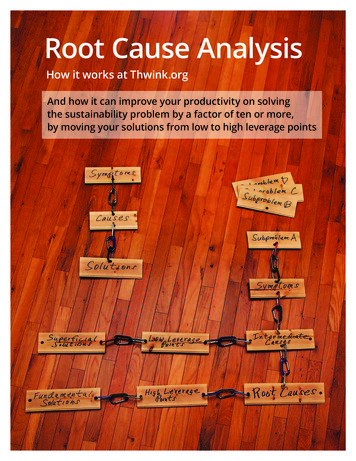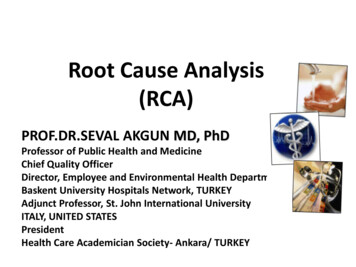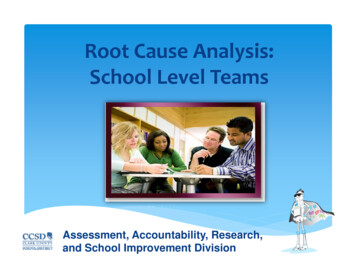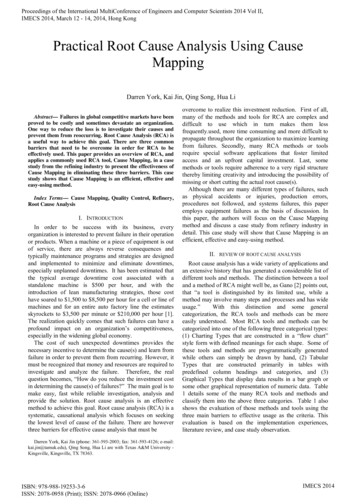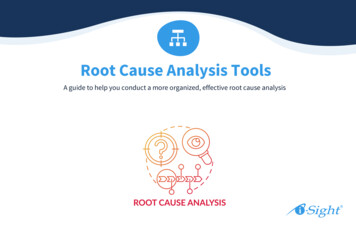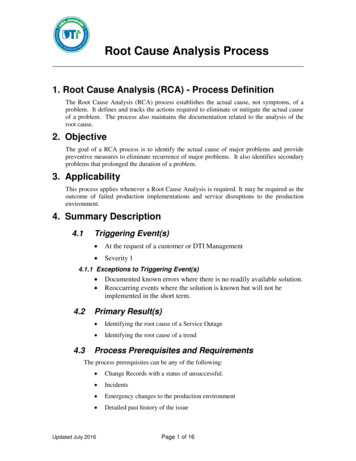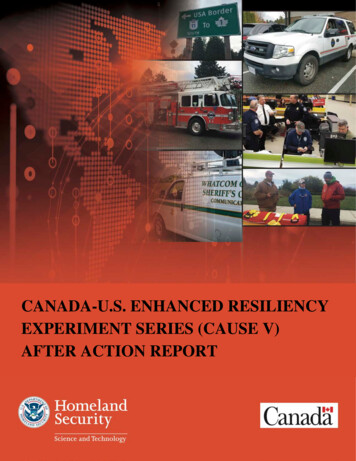
Transcription
CANADA-U.S. ENHANCED RESILIENCYEXPERIMENT SERIES (CAUSE V)AFTER ACTION REPORT
Task Lead:Denis GustyDHS S&T USAPrincipal Investigators:Walt Magnussen, Erik Endrulat,Jeff Sopel and Sarah PerlsteinTexas A&M University, G&HInternationalTask Lead:Philip Dawe, Glen Weimer,Jennifer Gosselin and JoeFournierDRDC CSSCanada-U.S EnhancedResiliency Experiment(CAUSE V)Binational After Action ReportPrincipal Investigators:Joe Fournier, Jacob Gurnick,Steven Tomich, Joe Wilson,Vincent Picard, Charles Auger,Charles Nadeau, SébastienLaflèche, Veronique Lafreniere,Alicia Armitage, StevenDowker, Kelly Forbes and IanBeckingDRDC CSS, CRC andInternational Safety ResearchPrepared forDepartment of Homeland SecurityScience and Technology Directorate,First Responders Group
Table of ContentsExecutive Summary . ivAcknowledgements. vIntroduction . 1CAUSE Series . 1CAUSE V Experiment. 2Experiment Design and Methodology . 4Participating Organizations . 4Location . 7Experiment Planning. 8Scenario Design and Experiment Conduct . 12Technology Use . 15Evaluation Process . 23Findings . 27Information Sharing and Decision Making . 27Interoperability and Coordination . 30Emergency Operations Technology . 32Social Media / Digital Volunteers . 33CAUSE V Metrics . 34System Interoperability and Technology Findings . 37Experiment design and conduct . 43Summary and Recommendations . 46Summary . 46Recommendations . 48Conclusion . 51References . 52Appendix 1 - Experiment Schedule . 55Appendix 2 - Wireless Users . 56Appendix 3 - Experiment Capability Needs. 57Appendix 4 - Technology Used During Experiment . 58Appendix 5 - UAV/UAS Missions . 65ii
Index of FiguresFigure 1. Map of CAUSE Experiment Locations. . 1Figure 2. Map of physical locations involved with CAUSE V. . 7Figure 3. The Mutual Aid Resource Planner (MARP) application with the Core Capabilities for theVolcanic Hazard. . 10Figure 4. Social Media Workflows tested during CAUSE V. . 12Figure 5. USGS Volcanic Hazard Map for Mt. Baker. . 13Figure 6: CAUSE V Wireless Deployment. . 16Figure 7: Predicated Wireless Coverage. . 17Figure 8: CAUSE V – System Level Diagram. . 18Figure 9. The CAUSE V Home App with embedded COP and Operations Dashboards. . 21Figure 10. Drakontas DragonForce application, showing the chat widget and map view containinginformation shared from the ArcGIS Online platform. . 22Figure 11. Overview for the information sharing processes tested during CAUSE V. . 23Figure 12. The SAFECOM Interoperability Continuum. . 25Figure 13. Social Media in Emergency Management Maturity Model. . 25Figure 14. Player assessment of CAUSE V technology. . 28Figure 15. An example of the time-based lahar inundation model, showing time points (in hours /minutes) for the lahar to reach different locations. . 29Figure 16. Player evaluation related to interoperability and coordination. . 31Figure 17. Player evaluation related to technology usage. . 32Figure 18. Player evaluation related to digital volunteers and social media. . 34Figure 19. Evaluator assessment of technology impact during CAUSE V. . 35Figure 20. Evaluator assessment of technology across the phases. . 35Figure 21. RESPOND-R Mobile Lab stationed in Sumas, WA. . 40Figure 22. Several UAS devices connected to solar panels for recharging in the foreground, with a UMV(EMILY) in background. . 40Figure 23. Sample orthomosaic map product of the Nooksack River captured by the UAV Team. . 41Figure 24. Participant feedback on effect of technology. . 44Index of TablesTable 1. Overview of Capabilities and Key Technologies Demonstrated During CAUSE Experiment Series 2Table 2. Descriptions of Existing Cross-border Working Groups. . 3Table 3: List of U.S. and Canadian agencies that participated in CAUSE V. . 6Table 4. Schedule of planning meetings, virtual and hands-on training and dry runs (all dates in 2017). . 8Table 5. List of environmental sensors and robot technology tested during CAUSE V. . 20Table 6. Missions carried out by the UAS/UMV Robot teams. . 39Table 7: Strengths and Areas for Improvement in the use of the CAUSE V Technology. . 42iii
Executive SummaryThe Beyond the Border (BTB) Action Plan, released in 2011, outlined joint priorities and specificinitiatives for cross-border collaboration between Canada and the United States (U.S.). This partnershipis focused on enhancing the coordination of multi-agency emergency management (EM) responsesduring binational disasters. In order to enhance cross-border Emergency Manager (EM) capabilities,interoperability and situational awareness (SA), Defence Research and Development Canada (DRDC)Centre for Security Science (CSS), Public Safety (PS) Canada and the Department of Homeland Security(DHS) Science and Technology Directorate (S&T) have collaborated to design the Canada-U.S. Enhanced(CAUSE) Resiliency experiment series. This series used a scenario-based approach to simulate the use ofinteroperable and emerging technologies during cross-border emergencies.In November 2017, the fifth experiment in the series, CAUSE V, took place in British Columbia (BC),Canada and the state of Washington (WA), U.S. This experiment provided an opportunity to test andexplore a suite of emerging technologies and applications to support an interoperable cross-borderresponse to simulated flooding and lahar flows. The objectives of this experiment were to test emergingtechnologies and the use of digital volunteers in supporting interoperable communications andinformation sharing between cross-border EM organizations.Qualitative and quantitative data were collected during the experiment to measure the impact of theemerging technology on EM operations. Overall, the analyses suggested the technologies andapplications supported the planning, response and recovery of a simulated emergency. The results ofthe evaluation process indicated the technology enhanced the reach, range and quality of informationexchanged among cross-border partners during emergency operations.CAUSE V technology supported geographically distributed organizations in their efforts to shareinformation in a common forum and in multiple formats. The digital volunteers successfully supportedEM decision makers through the collection and sharing of relevant information. The technology alsosuccessfully supported the incorporation of real-time resource tracking and information exchange withfield resources and the inclusion of data acquired by environmental sensors and robots. Use ofprioritized wireless networks ensured communications and data transfer between the field and EMorganizations on both sides of the border continued, despite network congestion or failure.This experiment investigated the use of new and emerging technologies to support and enhance currentresponse processes and protocols. Official mutual aid activation and inter-agency notificationprocedures will require additional investigation and awareness. The use of unmanned aerial andsubmersible robots to support reconnaissance and search and rescue (SAR) operations yielded vastamounts of data, and exposed challenges related to sharing that data over the wireless networks. Thesechallenges may be addressed by new data processing techniques. As well, processes involvinginformation exchange with digital volunteers and their integration into cross-border EM operationsrequire further development and adoption.The evaluation of the experiment data considered the potential for modifications and identifiedstrengths and areas for improvement. A set of recommendations was generated to guide the futureimplementation and use of these technologies during daily and emergency operations. In addition, theimplementation must be supported by more frequent and focused training opportunities to ensure thetechnologies can be used effectively during large-scale cross-border emergencies.iv
AcknowledgementsThe success of the CAUSE Experiment series, including the CAUSE V event, is due the commitment ofmany organizations, and the contributions of time and effort towards a common goal. A special thanksto the following groups: Abbotsford Fire Rescue ServicesBlaine Washington School DistrictCanada Border Services Agency (CBSA)CANARIE NetworkCascadia Virtual Operation Support Team (VOST)Communications Research Centre (CRC) Canada - Innovation, Science and EconomicDevelopmentDefence Research and Development Canada's Centre for Security Science (DRDC CSS)Emergency Management British ColumbiaE-Comm 911FirstNetInternet2Langley Emergency ProgramNew Westminster Fire Rescue ServicesNational Information Sharing Consortium (NISC)Nooksack Valley Washington School DistrictPublic Safety (PS) CanadaSemiahmoo First Nation Emergency Preparedness TeamTexas A&M University Center for Robot-Assisted Search and Rescue (CRASAR)Texas A&M University Internet 2 Technology Evaluation Center (ITEC)University of WashingtonU.S. Geological Survey’s (USGS) Cascade Volcano ObservatoryU.S. Department of Homeland Security (DHS) Office of Emergency Communications (OEC)U.S. DHS Science and Technology Directorate (S&T) First Responder Group (FRG)U.S DHS, U.S Customs and Border ProtectionVictoria Fire DepartmentWashington State Emergency Management Division (EMD)Whatcom County Division of Emergency ManagementWilliamsv
vi
IntroductionCAUSE SeriesIn 2011, then Prime Minister Steven Harper and the President Barack Obama established the Canada –United States (U.S.) Beyond the Border (BTB) Action Plan [1] [2]. The plan supports endeavours that leadto security enhancements along the shared border while aiming to improve the effective crossing ofsecure and legitimate people, goods and services. Further, this partnership helps to ensure binationalcoordination is not geographically limited to the border crossing, but rather it is extended to publicsafety issues that simultaneously affect both nations, regardless of where incidents occur. Measures inthe BTB Action Plan cover a range of security-focused objectives, including improving binationalresponses to large-scale disasters through improved communications interoperability.To address these objectives, several cross-border working groups were established, including theCanada-United States (CANUS) Communications Interoperability Working Group (CIWG). In 2012, theCANUS CIWG developed a five-year work plan with specific goals and activities, several of which areaddressed through the development of the Canada-United States Enhanced (CAUSE) ResiliencyExperiment series.The CAUSE experiment series has been built upon a strong collaboration between Defence Research andDevelopment Canada (DRDC) Centre for Security Science (CSS), Public Safety (PS) Canada and the U.S.Department of Homeland Security (DHS) Science and Technology Directorate (S&T). The CAUSEexperiment series supports the BTB Action Plan by demonstrating that emerging technologies for sharedsituational awareness (SA) and interoperable communications during emergency events can lead toenhanced community resilience. The events carried out as part of the CAUSE experiment series haveconfirmed that disasters occurring alongthe CANUS shared border requires closecooperation between officials in bothcountries. The shared goal within thispartnership is centered on enhancing thecoordination of emergency responsesduring disasters affecting both countries.CAUSE V is the fifth experiment in thisseries. The series began with CAUSE I,which took place on the west coast inJune 2011 [3]. The second experiment,CAUSE II [4], took place on the east coast Figure 1. Map of CAUSE Experiment Locations.in March 2013, while the thirdexperiment, CAUSE III, took place in both eastern [5] and western border communities [6] in 2014 andfocused on different response and recovery aspects in each region. CAUSE IV was conducted in SouthernOntario and the state of Michigan in 2016 [7]. The most recent experiment, CAUSE V, was held in 2017and returned to the west coast to focus on border communities within the Sumas, Washington (WA) andAbbotsford, British Columbia (BC) regions (Figure 1).CAUSE V – After Action ReportPage 1 of 75
While each of the experiments were guided by the overarching objectives of the CAUSE experimentseries, each individual experiment focused on key capability areas and technological solutions relevantto the particular geographical regions where they were held (Table 1). Information sharing and sharedsituational awareness using emerging technologies has been an underlying theme across eachexperiment. Alert and warning activities, including integration of the U.S. Integrated Alert and WarningSystem (IPAWS), Canadian Multi-Agency Situational Awareness System (MASAS) and the National AlertAggregation & Dissemination System (NAADS) were included in CAUSE I-IV. Risk planning factored intoCAUSE I, IV and V, involving evaluating and predicting the impact of natural and man-made hazardsusing technology such as HAZUS and other GIS-based tools. Mutual Aid and resource planning were keycomponents of CAUSE II-IV, where participants tested systems, including the Mutual Aid Support System(MASS) and Mutual Aid Resource Planner (MARP) for managing and tracking mutual aid resources andrequests for resources. Communications interoperability involving land mobile radio (LMR) andbroadband was foundational to all of the CAUSE experiments other than CAUSE II. And, the use of digitalvolunteers to augment emergency operations by monitoring social media were part of CAUSE III-V.Table 1. Overview of Capabilities and Key Technologies Demonstrated During CAUSE Experiment SeriesCapabilityInformation Sharing; SharedSituational AwarenessAlert & WarningRisk PlanningMutual Aid, Resource PlanningComms: Land Mobile Radio (LMR)Comms: Long-Term Evolution (LTE)wireless networksDigital VolunteersCAUSE I CAUSE II CAUSE IIICAUSE IV CAUSE V CAUSE V ExperimentThe latest experiment in the series was CAUSE V, held in November 2017 between lower mainland BCand Whatcom County in Northern WA. The scenario for this experiment was a Mt. Baker eruption andthe resulting lahar flow that affected the river valleys below.The purpose of the CAUSE V experiment was to use a hazard-based scenario along the CANUS border toevaluate the impact of enhanced interoperable communications, information sharing technologies,mutual aid planning and response technologies on multi-agency planning, response, and recovery.Enhanced SA for first responders in emergencies was a key way to evaluate the success of theseemerging technologies. The CAUSE V experiment objectives were developed to test emergingtechnologies. The inclusion of digital volunteers as a means to support interoperable communicationsand information sharing between cross-border EM organizations during a large-scale disaster was alsoinvestigated.CAUSE V – After Action ReportPage 2 of 75
The specific objectives developed for the CAUSE V experiment were:1. Leverage long-term evolution (LTE) networks to create a common operating picture (COP) toenhance decision making and increase the ability of various emergency operation centres (EOC)and other agencies to receive information from multiple responding agencies;2. Provide live, or near real-time data and imagery from the field leveraging robots andparticipants in the field to COP applications in EOCs via LTE network;3. Explore the use of digital volunteers to support emergency operations;4. Test the Pacific Northwest Emergency Management Arrangement (PNEMA) for state-toprovincial mutual aid requests leveraging the Emergency Management Assistance Compact(EMAC) Operating System; and5. Test the process for moving specialized resources and personnel across the CANUS border.Due to real-life constraints, the inclusion of the EMAC Operating System to leverage PNEMA wasomitted from the experiment.The experiment was developed based on the findings and lessons identified from previous CAUSEexperiments. As well, input and guidance was gathered from local participants, including members ofexisting cross-border working groups (Table 2), to ensure the issues investigated were relevant to thelocal geographical region. As with previous experiments, the intent was to use CAUSE as a catalyst toadvance the goals of the BTB Action Plan by expanding cross border coordination among responseagencies, thereby enhancing resilience to cross-border disasters.Table 2. Descriptions of Existing Cross-border Working Groups.Working Group NameMutual Aid GroupLaw EnforcementGroupCommunications GroupPurposeFocuses on planning for cross border mutual aid requests withinlower mainland British Columbia (BC) and northwest WA Thisincludes planning for equipment needs, expedited bordercrossing, cross training in U.S and Canadian courses, and policyfor cross border MOU's.Facilitates planning for cross border law enforcement activitiesalong the border.Discusses issues and solutions for cross border communicationsfor first responders and receivers. It was mentioned that CBSAand CBP have been excellent for organizing and hosting meetingsof this group.In CAUSE II, III and IV, a single scenario with two separate vignettes was used to meet the objectives ofthe experiment. One vignette focused primarily on broadband wireless communications andinformation sharing whereas another focused on various capabilities that included alerts and warningssystems, digital volunteers, social media and information sharing that provided enhanced SA to EOCs,emergency managers, and first responders. Both vignettes were indirectly tied together by a commonscenario and inter-related experiment injects. In the case of CAUSE V, a key goal and major achievementwas to tie all components of the experiment together in a manner that would further enhance the SA ofemergency managers at EOCs as well as all wireless participants [8].CAUSE V – After Action ReportPage 3 of 75
Experiment Design and MethodologyCAUSE V was held November 15-16, 2017. Multiple training sessions were held prior to the experimenton November 14, and a half-day After Action Review (AAR) was held upon completion of theexperiment, on November 17. A full experiment schedule can be found in Appendix 1. The timing foreach phase of the experiment (i.e., planning, response, recovery) were general guidelines andaccommodated pauses in the experiment to address any unforeseen delays or issues.While CAUSE V was carried out over a two day period, the scenario timeline spanned many months asparticipants reacted to the threat of an eruption, responded to both the eruption and the resulting laharflow, and finally began recovery operations. In addition to the fixed EOCs and emergency managers, thelist of wireless users in the experiment included first responders, Canada and the U.S. border agenciesand First Nations. In addition, the experiment supported the use of drones, robots, sensors andcommercial users [8].Although not carried out as a traditional exercise, the experiment was designed and executed based onexercise design best practices, including the development of a master scenario events list (MSEL) andexperiment control procedures. Where necessary, these procedures were modified to suit the specificrequirements of the experiment objectives. An evaluation process, involving pre-experiment interviews,observations gathered during the two-day event and data gathered via the administration of postexperiment surveys, was used to measure the impact of the emerging technologies tested during theexperiment.Participating OrganizationsMore than 60 individuals from approximately 24 local, provincial / state, federal and private sectoragencies actively participated or observed the experiment, with nearly twenty using broadband wirelessnetworks. Federal departments from both Canada and the U.S. provided oversight to the development,delivery and evaluation of this experiment. The lead federal departments were: U.S. DHS S&T;DRDC CSS; andPS Canada.Technology SupportNumerous organizations were involved with the configuration of the technology used during theexperiment, offering on-site and virtual training to participants, and providing technological support toparticipants on the use of the emerging technologies and applications during the experiment. Theseorganizations included: DRDC CSS;Communications Research Centre (CRC) Canada;Roboticists Without Borders;Texas A&M Internet 2 Technology Evaluation Center (ITEC);International Safety Research (ISR) (under contract of DRDC CSS); andG&H International (under contract of DHS S&T).CAUSE V – After Action ReportPage 4 of 75
Experiment Design TeamThe Experiment Design Team (EDT) was primarily responsible for developing the experiment scenario,experiment plan and MSEL. This group was comprised of representatives from the primary participatingagencies and representatives from each federal lead department. Organizations involved within thisgroup included: ISR (under contract of DRDC CSS);G&H International (under contract of DHS S&T);DRDC CSS;DHS S&T FRG; andMembers of selected organizations as identified in Table 3 below.ControllersControllers were responsible for managing overall experiment conduct, including control of the pace ofthe experiment and delivering injects to participants. Controllers for the experiment were a group oftrusted agents from the following organizations: DHS Customs and Border Protection (CBP);Canada Border Services Agency (CBSA);Langley Emergency Program;ISR (under contract of DRDC CSS); andG&H International (under contract of DHS S&T).EvaluatorsThe Evaluators managed the data collection for CAUSE V, including gathering observational data(quantitative and qualitative) and supporting the acquisition of participant data before and after theexperiment. Controllers for the experiment were a group of trusted agents from the followingorganizations: ISR (under contract of DRDC CSS);G&H International (under contract of DHS S&T);DHS Office of Emergency Communications (OEC); andMembers of selected organizations as identified in Table 3 below.Participating OrganizationsParticipants from 30 agencies participated in, and / or observed the experiment (Table 3).CAUSE V – After Action ReportPage 5 of 75
Table 3: List of U.S. and Canadian agencies that participated in CAUSE V.United States Cascade Gas Cascadia Virtual Operations Support Team(VOST) City of Bellingham CBP EDT Eval FirstNet National Institute of Standards andTechnology (NIST) Puget Sound Energy Roboticists Without Borders Seattle City Light U.S DHS Office of EmergencyCommunications (OEC)Eval U.S DHS S&T DirectorateEDT U.S Geological Survey’s Cascade VolcanoObservatory EDT Washington State Emergency ManagementDivision (EMD) Western Washington University Whatcom County Division of EmergencyManagement EDT Williams Texas A&M UniversityCanada Abbotsford Fire Rescue ServiceEDT CBSAEDT Eval CRC Canada DRDC CSSEDT E-Comm 911EDT Emergency Management B.C. (EMBC)Eval Fraser Valley Regional District Eval Langley Emergency ProgramEDT Eval New Westminster Fire & Rescue ServicesEval PS CanadaEDT Semiahmoo First Nation EmergencyPreparedness Team Surrey RCMP Victoria Fire DepartmentEvalWireless UsersIn CAUSE V, a large number of the participants used wireless networks to access a wide variety ofapplications to communicate and share information with each other as well as with the two EOCs. Someusers were in fixed locations while others were mobile. Furthermore, while most wireless users werehumans, the sensors, drones and robots also used wireless networks.Appendix 2 lists the users directly involved with the use of wireless equipment.Wireless devices allowed users to view and upload information to the COP while within range of thewireless networks. Four vehicles in the experiment were equipped with modems and laptops as werethe CBSA border sites at Surrey and Abbotsford and the U.S CBP border sites at Blaine and Sumas. Eachlaptop was set up with a suite of applications that was used to support participants’ involvement in theexperiment. The EOC laptops were connected via Ethernet and had all applications the wireless usershad, thus allowing them to fully communicate and share information with all CAUSE V participants andas required, the outside world. Two sensor platforms with vibration, water level and temperaturemonitoring used Band 14 modems, as did the drone / robot platform provided by Texas A&M University.Eight smartphones were provided to participan
experiment, CAUSE III, took place in both eastern [5] and western border communities [6] in 2014 and focused on different response and recovery aspects in each region. CAUSE IV was conducted in Southern Ontario and the state of Michigan in 2016 [7]. The most recent experiment, CAUSE V, was held in 2017


